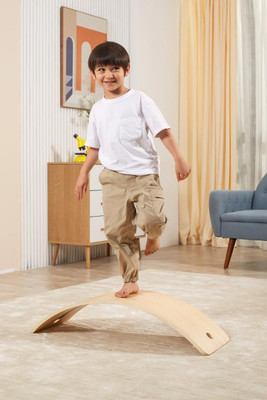Risky Play: Safe Ways for Kids to Test Their Limits
Aug 26, 2025
Children love to climb higher, jump further, and try things that make our hearts skip a beat. For parents and educators, it can feel nerve-wracking to watch. But what’s often called “risky play” is actually an important part of healthy development.
Risky play does not mean putting children in danger. It means giving them the freedom to test their limits in a safe environment, whether that is climbing, balancing, exploring heights, or even a bit of rough-and-tumble. These experiences build confidence, resilience, and problem-solving skills that no worksheet or screen can teach.
What is Risky Play?
Risky play is any activity where children push themselves just beyond what feels comfortable, while still being safe. It is the kind of play that challenges children to stretch their physical and emotional boundaries. Examples include climbing a ladder or play structure, walking across balance beams or stepping stones, riding a bike down a gentle slope, or engaging in energetic play such as rolling, wrestling, or chasing.
In early childhood, children naturally seek out these experiences. They want to know how high they can climb, how far they can jump, or how fast they can ride. While this might look intimidating to adults, it is through these very experiences that children learn to manage their bodies, their emotions, and their decision-making.
According to the Raising Children Network, outdoor and adventurous play gives children the chance to make small mistakes, test boundaries, and build the resilience to bounce back stronger.
Why Is It Good for Children?
So why is it worth encouraging? Here are some of the biggest benefits children gain through this type of play.
Builds Confidence and Resilience
Every time a child climbs higher than they did yesterday or balances on something a little narrower, they experience a sense of accomplishment. These small victories build confidence and self-belief. When they stumble or fall, they also learn an equally valuable lesson: setbacks are not failures but stepping stones.
Supports Physical Development
Activities such as climbing, jumping, running, and balancing all strengthen muscles and coordination. Natural play pieces like beams, ropes, or gentle slopes in the garden give children a safe way to test their bodies while building strength and agility.
Encourages Risk Assessment
Children constantly judge situations during play. Should they jump to the next log? Can they make it across the low bridge? These decisions help them learn to measure risk and act carefully. Small-scale challenges like stepping stones, climbing nets, or balance paths encourage this kind of thoughtful judgement.
Boosts Emotional Growth
The thrill of achieving something new brings joy and pride, while the occasional wobble teaches self-regulation. Open-ended setups such as arches, tunnels, or even cushions stacked for safe leaps give children different ways to experiment, build confidence, and celebrate their progress.
How Parents and Educators Can Support Risky Play
Supporting risky play is about striking the right balance between freedom and safety. Parents and educators play a vital role in setting boundaries that keep children safe while still allowing them to explore.
Create Safe Environments: Make sure play equipment is stable and age-appropriate. Use soft surfaces like grass, mats, or sand under climbing areas to soften falls. Provide helmets for bikes and scooters.
Supervise Without Hovering: Being present does not mean stepping in at every wobble. Sometimes the best support is simply being nearby and letting children work things out on their own. This builds trust and independence.
Offer the Right Tools: Encourage different forms of movement by rotating what’s available—climbing frames for strength, ride-ons for coordination, stepping logs for balance, and tunnels for creative exploration. Younger children may enjoy low ride-ons like the Wheely Bug Pig, while older ones thrive with more challenging equipment such as wobble boards or climbing nets.
The ACECQA guide on adventurous play highlights how early childhood educators can build a culture where children are challenged, supported, and encouraged to explore without unnecessary restrictions. When children feel trusted to take measured risks, they become more capable of managing themselves and others.
Risky play might look a little daring, but it is one of the healthiest things you can encourage in a child’s world. By giving children space to climb, balance, and explore, you are supporting their physical growth, helping them develop confidence, resilience, and lifelong problem-solving skills. With safe environments, thoughtful supervision, and play equipment that stretches their abilities, risky play becomes an adventure where children can thrive.


